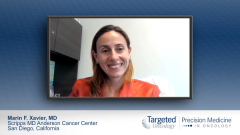
DLBCL Risk Status and Frontline Treatment Decisions
The differences between frontline treatment strategies for early stage vs double- or triple-hit diffuse large B-cell lymphoma.
Episodes in this series

John M. Burke, MD: Do you want to talk about early stage disease. What’s your approach to early stage large cell lymphoma?
Marin F. Xavier, MD: That’s definitely different. For most patients, if I had to do a 1-size-fits-all [response], depending on their disease—if I can sense that they’re responding well enough—I try to wait until after cycle 4 and then do a PET [positron emission tomography]–CT scan and 2 additional cycles beyond PET CRU [complete remission unconfirmed]. That’s my ideal situation. As long as I’m fairly certain they’re responding early, I don’t always do 1 after 2 cycles if their palpable disease is remitting. Then there’s the situation of can you do a short course if they’re stage I or II? I do 3 or 4 cycles followed by consolidative radiotherapy if it’s bulky.
John M. Burke, MD: I do the same thing.
Marin F. Xavier, MD: Not necessarily bulky but limited. You should incorporate a radiotherapy. Don’t you?
John M. Burke, MD: Yeah, and the 2 trials that have changed things for me were the FLYER trial and the SWOG trial. FLYER was a young patient population with no risk factors. The Southwest Oncology Group did a more inclusive trial of stage I/II disease, and they weren’t all low-risk patients. Their algorithm was to do a nonrandomized trial, but they did 3 cycles of R-CHOP [rituximab, cyclophosphamide, hydroxydaunorubicin hydrochloride, vincristine, prednisone] followed by an interim PET. The large majority of patients had interim PET that was negative after 3 cycles. If the patients had that, then they just gave a fourth cycle and stopped. They reported a 5-year follow-up that was published in JCO [Journal of Clinical Oncology] in 2019. They reported a very low risk of relapse, in the single digits, and very few deaths from lymphoma in more than 100 patients they treated.
Marin F. Xavier, MD: That was without radiotherapy. That was just for PET CRs [complete responses] after 3, right?
John M. Burke, MD: Yes, correct.
Marin F. Xavier, MD: And for all stages.
John M. Burke, MD: I’ve taken to adopting that. The last time I looked at NCCN [National Comprehensive Cancer Network Guidelines], they still advocate what you did: if they’re bulky, either give more cycles of R-CHOP [rituximab, cyclophosphamide, hydroxydaunorubicin hydrochloride, vincristine, prednisone] or incorporate radiation therapy. For the less bulky ones, I try to stop after 4 cycles as long as they have that negative interim PET after 3.
Marin F. Xavier, MD: An interesting study that came out of ASH [American Society of Hematology Annual Meeting] about 3 years ago—it was really striking to me—is that you would always imagine that if patients did not have a PET CR after a full course of radiotherapy, in areas of bulk they did poorly. But if you added radiotherapy, those patients had excellent long-term outcomes. That stuck with me. I have a few long-term survivors who were able to radiate residual PET disease and still have a great outcome.
John M. Burke, MD: What about your approach to the double? What do you do for double and triple hits?
Marin F. Xavier, MD: Those patients do usually get R-EPOCH [rituximab, etoposide, prednisone, vincristine, cyclophosphamide, hydroxydaunorubicin hydrochloride] with intrathecal chemotherapy. Depending on the situation, I would do some medium- to high-dose methotrexate as well for CNS [central nervous system] prophylaxis. Those patients I do similarly. We have the ability to do outpatient R-EPOCH [rituximab, etoposide, prednisone, vincristine, cyclophosphamide, hydroxydaunorubicin hydrochloride], which is really helpful. We basically just give them the additional etoposide and dose adjust them aggressively, looking for nadir blood counts and escalating their dose as appropriate. That’s probably the only difference. I do feel that for those patients, if they don’t achieve complete response or if they relapse within 6 months of their chemotherapy, you shouldn’t even think about chemotherapy. I’m really looking forward to using cellular therapy or a noncytotoxic option for that area of unmet need. I’m hoping that we’re going to see some emerging data about moving CAR [chimeric antigen receptor] T cells in the second line for that ultra-high-risk population.
John M. Burke, MD: That would be interesting. I confess: all the experts in all the talks I go to recommend exactly what you just said, which is dose-adjusted EPOCH [etoposide, prednisone, vincristine, cyclophosphamide, hydroxydaunorubicin hydrochloride], for a more aggressive regimen. It’s a little frustrating that it’s all based on mostly retrospective data and not a lot of prospective data, and certainly not on comparative trials. The 1 comparative trial between dose-adjusted EPOCH [etoposide, prednisone, vincristine, cyclophosphamide, hydroxydaunorubicin hydrochloride], and R-CHOP [rituximab, cyclophosphamide, hydroxydaunorubicin hydrochloride, vincristine, prednisone] that we have in large cell lymphoma was a negative 1. There was 0 difference in outcomes and more toxicity with dose-adjusted EPOCH [etoposide, prednisone, vincristine, cyclophosphamide, hydroxydaunorubicin hydrochloride]. I do the same as you, but I wonder if we’re just repeating errors of the past by adding more aggressive regimens based on noncomparative data. I wonder if we’re improving outcomes with more aggressive regimens.
Marin F. Xavier, MD: With the new WHO [World Health Organization] criteria, I have a case I’m struggling with right now where it seems like a Burkitt-like [lymphoma]. He’s c-MYC positive, but BCL2 to BCL6 negative and it’s a high grade. I have to do a hematopathology review because it’s so atypical. I always was suspicious in a different direction, that if you’re lumping these Burkitt-like ones that we now call triple hits, those were the really bad chemotherapy-refractory and chemotherapy-kinetic failures. I never believed in R-EPOCH [rituximab, etoposide, prednisone, vincristine, cyclophosphamide, hydroxydaunorubicin hydrochloride] for that. I believed they had to have a more hyper CVAD-R [cyclophosphamide, vincristine, hydroxydaunorubicin hydrochloride, dexamethasone, rituximab]with CNS-penetrating medications. The NIH [National Institutes of Health] data in that scenario is too good to be true for R-EPOCH [rituximab, etoposide, prednisone, vincristine, cyclophosphamide, doxorubicin hydrochloride]. So I’m equally suspicious in the other direction as well.
Transcript edited for clarity.







































